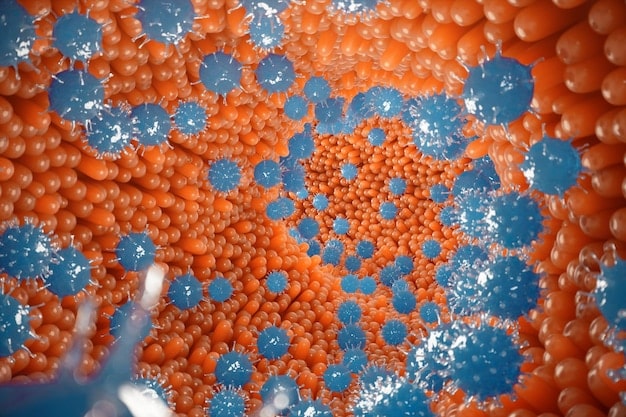Cancer Immunotherapy: Breakthroughs for Stage IV Patients

Immunotherapy represents a transformative frontier in cancer treatment, offering unprecedented hope and tangible improvements in outcomes for patients battling stage IV malignancies by harnessing the body’s own immune system to fight cancer cells effectively.
The landscape of cancer treatment is constantly evolving, with dedicated researchers and clinicians relentlessly seeking innovative strategies. Among the most promising avenues to emerge in recent years are The Latest Advancements in Cancer Immunotherapy: A Breakthrough for Stage IV Patients, revolutionizing how we approach even the most advanced forms of the disease.
Understanding Stage IV Cancer and the Need for New Approaches
Stage IV cancer, also known as metastatic cancer, signifies that cancer cells have spread beyond the primary tumor site to distant parts of the body. This advanced stage historically presented a formidable challenge, often associated with limited treatment options and a poor prognosis. Conventional treatments like chemotherapy and radiation therapy, while effective for many localized cancers, often struggle to achieve significant long-term control over widespread metastatic disease.
The complexity of stage IV cancer stems from its systemic nature, requiring therapies that can target cancer cells throughout the entire body without causing debilitating side effects. The development of therapies that work broadly and effectively, yet selectively, has been a long-standing goal in oncology. For decades, the focus was primarily on directly attacking cancer cells, often leading to collateral damage to healthy tissues.
The Historical Limitations of Traditional Treatments
For patients with stage IV disease, traditional chemotherapy aimed to kill rapidly dividing cells, but its non-specific nature meant healthy cells were also affected, leading to severe side effects and often drug resistance. Radiation therapy could only target specific areas, proving ineffective against widespread metastases. These limitations underscored the urgent need for a paradigm shift.
The quest for more targeted and less toxic treatments has been a driving force in oncology research. While surgical removal and localized radiation can cure early-stage cancers, their utility diminishes significantly once the disease has spread. Chemotherapy, despite being a systemic treatment, often faced challenges with drug resistance and dose-limiting toxicities, leaving many patients with few viable options.
The Shift Towards Precision Medicine
The emergence of precision medicine, driven by a deeper understanding of cancer’s molecular underpinnings, began to offer glimmers of hope. This approach involves identifying specific genetic mutations or protein expressions within a tumor that can be targeted by drugs. While a significant step forward, even precision therapies often face challenges like the development of resistance mechanisms over time within heterogeneous tumor cell populations.
This evolving understanding paved the way for entirely new treatment modalities. The recognition that the immune system plays a crucial role in preventing and controlling cancer has fundamentally reshaped research priorities. Instead of solely focusing on eliminating cancer cells directly, the new frontier involves empowering the body’s natural defenses to do the job.
Our growing knowledge of tumor biology, coupled with advancements in genomic sequencing, has illuminated the intricate ways cancer evades immune surveillance. This insight has been critical in designing therapies that counteract these evasive strategies, making the immune system a formidable weapon against the disease.
Historically, an ‘attack the cancer’ mentality dominated. Now, a ‘empower the body’ approach is gaining prominence, marking a transition from blunt instruments to sophisticated, highly targeted interventions. This shift is particularly vital for stage IV patients, where systemic and nuanced solutions are paramount.
The Core Principles of Cancer Immunotherapy
Cancer immunotherapy is a groundbreaking approach that harnesses the power of the body’s own immune system to identify and destroy cancer cells. Unlike traditional treatments that directly target cancer, immunotherapy works by boosting the immune system’s natural ability to fight the disease. The fundamental principle behind this approach is the recognition that the immune system, under normal circumstances, is capable of detecting and eliminating abnormal cells, including cancerous ones.
However, cancer cells often develop sophisticated mechanisms to evade immune detection and destruction. They can mimic healthy cells, suppress immune responses, or create a protective microenvironment that shields them from immune attack. Immunotherapy aims to overcome these evasive strategies, effectively ‘releasing the brakes’ on the immune system or ‘stepping on the gas’ to enhance its anti-cancer activity.
Key Mechanisms of Action
The various forms of immunotherapy operate through distinct mechanisms, but they all share the common goal of empowering the immune system. One prominent mechanism involves immune checkpoint inhibitors (ICIs), which block proteins (checkpoints) that normally prevent immune cells from attacking healthy cells. Cancer cells often exploit these checkpoints to avoid detection. By blocking them, ICIs effectively unleash the immune system to target tumors.
Another crucial mechanism is adoptive cell therapy, which involves extracting immune cells (usually T-cells) from a patient, genetically modifying them in a lab to specifically target cancer cells, multiplying them, and then reinfusing them back into the patient. Chimeric Antigen Receptor (CAR) T-cell therapy is a prime example of this personalized approach, demonstrating remarkable success in certain blood cancers.
- Immune Checkpoint Inhibition: Blocking proteins like PD-1, PD-L1, and CTLA-4 that normally suppress immune responses, thereby allowing T-cells to attack cancer more effectively.
- Adoptive Cell Therapy (e.g., CAR T-cells): Genetically engineering a patient’s own T-cells to recognize and destroy cancer cells, then reinfusing them.
- Therapeutic Cancer Vaccines: Training the immune system to recognize specific cancer antigens and mount an immune response against them.
- Monoclonal Antibodies: Lab-produced antibodies designed to bind to specific targets on cancer cells or immune cells, either directly killing cancer cells or marking them for immune destruction.
Other forms include oncolytic viruses, which are engineered viruses that infect and kill cancer cells while stimulating an anti-tumor immune response, and cytokines, which are proteins that regulate immune cell activity and can be used to enhance immune responses against cancer.
The beauty of immunotherapy lies in its potential for long-lasting responses. Unlike chemotherapy, which often has a temporary effect, a successfully activated immune system can develop a molecular ‘memory’ of the cancer cells, continuing to patrol the body and eliminate any remaining or newly emerging cancer cells, leading to durable remissions and, in some cases, even cures.
Understanding these different mechanisms is crucial for tailoring the most effective treatment strategy for each individual patient, considering the specific type of cancer, its genetic makeup, and the patient’s overall health and immune profile. This personalization is a hallmark of modern oncology.
Breakthroughs in Immune Checkpoint Inhibitors for Metastatic Disease
Immune checkpoint inhibitors (ICIs) have revolutionized the treatment of numerous cancers, particularly in the metastatic setting. These drugs work by blocking specific proteins, known as checkpoints, on immune cells or cancer cells that normally put the brakes on an immune response. By releasing these brakes, ICIs empower the body’s T-cells to recognize and attack tumor cells that were previously able to evade detection.
The initial success of ICIs, particularly those targeting PD-1 (Programmed Death-1) and CTLA-4 (Cytotoxic T-Lymphocyte-Associated protein 4), was observed in melanoma, a highly aggressive form of skin cancer. Before ICIs, metastatic melanoma had a grim prognosis; now, many patients achieve long-term survival, some even experiencing complete and durable remissions.

Expanding Indications and Combinations
Following their success in melanoma, ICIs have gained approval for an ever-growing list of advanced cancers, including lung cancer, kidney cancer, head and neck cancer, bladder cancer, and certain types of colorectal cancer. This expansion is a testament to their broad applicability and effectiveness across different tumor types.
- Non-Small Cell Lung Cancer (NSCLC): ICIs are now a frontline treatment for many patients with advanced NSCLC, significantly improving overall survival rates compared to traditional chemotherapy.
- Renal Cell Carcinoma (Kidney Cancer): Combination immunotherapy (e.g., PD-1 inhibitor plus CTLA-4 inhibitor) or immunotherapy plus a targeted therapy has become standard of care, offering superior outcomes.
- Hepatocellular Carcinoma (Liver Cancer): Combinations of ICIs and anti-angiogenic drugs are showing promising results for advanced liver cancer patients.
- Triple-Negative Breast Cancer: While challenging to treat, ICIs combined with chemotherapy have shown benefits in select patients with metastatic triple-negative breast cancer.
Furthermore, researchers are increasingly exploring combination therapies, where two different ICIs are used together (e.g., anti-PD-1 and anti-CTLA-4), or ICIs are combined with chemotherapy, targeted therapy, or radiation therapy. These combinations often aim to achieve synergistic effects, enhancing the anti-tumor immune response and improving outcomes for a broader range of patients.
The challenge with ICIs, however, lies in identifying which patients will benefit most and managing potential immune-related adverse events. While generally less toxic than chemotherapy, ICIs can cause inflammation in various organs due to an overactive immune response. Biomarkers, such as PD-L1 expression and tumor mutational burden, are being developed to help predict response and guide treatment decisions, moving towards a more personalized approach.
The ongoing clinical trials are continuing to push the boundaries of ICI applications, including in earlier stages of cancer to prevent recurrence, and in rarer tumor types where treatment options are limited. The landscape of ICI therapy is dynamic and rapidly evolving, offering continuous new hope.
The remarkable durability of responses seen with ICIs, even in some stage IV patients, underscores their transformative potential. Unlike other treatments that might extend life for a few months, some ICI responses can last for years, fundamentally altering the natural history of the disease for a significant subset of patients.
CAR T-Cell Therapy and Other Adoptive Cell Therapies
Chimeric Antigen Receptor (CAR) T-cell therapy represents one of the most sophisticated forms of immunotherapy, specifically a type of adoptive cell therapy. This highly personalized treatment involves engineering a patient’s own T-cells to express a specialized receptor (the CAR) that enables them to recognize and bind to specific proteins found on the surface of cancer cells. Once bound, these re-engineered T-cells become activated and are highly effective at destroying the cancer cells.
The process of CAR T-cell therapy involves several key steps: first, a patient’s T-cells are collected through a process similar to dialysis called apheresis. These T-cells are then sent to a lab where they are genetically modified to produce the CAR. After multiplication to generate millions of CAR T-cells, they are infused back into the patient, usually after a brief course of chemotherapy designed to deplete existing immune cells and make space for the infused CAR T-cells to expand and function effectively.
Current Successes and Expanding Horizons
CAR T-cell therapy has already achieved remarkable success, particularly in certain hematologic (blood) cancers. It has shown impressive remission rates in patients with relapsed or refractory B-cell acute lymphoblastic leukemia (ALL) and aggressive non-Hodgkin lymphomas, where other treatments had failed. For many patients, CAR T-cell therapy has offered a chance at long-term remission, and in some cases, a functional cure.
While the initial approvals were for specific blood cancers, research is intensely focused on expanding the application of CAR T-cells to solid tumors. Solid tumors present unique challenges for CAR T-cells, including a suppressive tumor microenvironment, physical barriers to T-cell infiltration, and heterogeneity of antigen expression. However, ongoing clinical trials are exploring various strategies to overcome these hurdles, such as:
- Targeting new antigens on solid tumors.
- Developing ‘armored’ CAR T-cells that secrete additional molecules to overcome the suppressive tumor microenvironment.
- Combining CAR T-cells with other immunotherapies or conventional treatments.
- Developing universal CAR T-cell therapies (allogeneic CAR T-cells) from healthy donors, which could make the therapy more accessible and reduce production time.
Despite their significant promise, CAR T-cell therapies are complex and carry unique side effects, such as cytokine release syndrome (CRS) and neurological toxicities, which require specialized management. These side effects are typically temporary but necessitate close monitoring in a hospital setting. The ongoing research is also directed at mitigating these adverse events while maintaining efficacy.
Beyond CAR T-cells, other forms of adoptive cell therapies are under investigation, including Tumor-Infiltrating Lymphocyte (TIL) therapy, where naturally occurring anti-tumor T-cells are isolated from a patient’s own tumor, expanded in the lab, and then reinfused. TIL therapy has shown promise in melanoma and is being explored in other solid tumors.
The field of adoptive cell therapy is rapidly advancing, with new engineering strategies and targets continually being identified. These therapies represent a beacon of hope for patients with advanced cancers, offering deeply personalized and potent anti-cancer immunity.
New Targets and Emerging Combinations in Immunotherapy
The success of immune checkpoint inhibitors and CAR T-cell therapies has spurred an explosion of research into new immunotherapy targets and novel combination strategies. Scientists are working diligently to identify additional ways to harness the immune system more effectively, particularly for patients who don’t respond to current immunotherapies or whose cancers develop resistance.
One major area of focus involves exploring other immune checkpoints beyond PD-1 and CTLA-4. Molecules such as LAG-3 (Lymphocyte-Activation Gene 3), TIM-3 (T-cell Immunoglobulin and Mucin Domain-containing 3), and TIGIT (T-cell Immunoreceptor with Ig and ITIM domains) are emerging as promising targets. Blocking these additional checkpoints could release even more ‘brakes’ on the immune system, potentially leading to stronger and more durable anti-tumor responses, especially in combination with existing ICIs.
Diverse Combination Strategies and Modalities
The future of immunotherapy likely lies in intelligent combinations. These aren’t just about combining two immunotherapies; they involve integrating immunotherapy with other established cancer treatments to optimize efficacy. For instance:
- Immunotherapy + Chemotherapy: Chemotherapy can sometimes induce immunogenic cell death, releasing tumor antigens that stimulate an immune response, making tumors more susceptible to immunotherapy.
- Immunotherapy + Radiation Therapy: Radiation, when delivered in specific ways, can also act as an in-situ vaccine, enhancing the immune response against cancer cells beyond the irradiated field.
- Immunotherapy + Targeted Therapy: Targeted drugs can sometimes make cancer cells more visible to the immune system or reduce the suppressive environment within the tumor.
- Immunotherapy + Oncolytic Viruses: Viruses engineered to infect and destroy cancer cells can also trigger an immune response against the tumor, complementing other immunotherapies.
Beyond these, new modalities like bispecific antibodies are gaining traction. These engineered antibodies can simultaneously bind to two different targets – for example, one on a cancer cell and another on an immune cell – effectively bringing immune cells directly to the tumor to unleash their destructive power. These are particularly intriguing for solid tumors where CAR T-cells face delivery challenges.
Another exciting area is the development of therapeutic cancer vaccines that aim to prime the immune system to recognize and attack specific cancer antigens. Unlike traditional prophylactic vaccines, these are designed to treat existing cancer by teaching the patient’s immune system to identify tumor-specific markers and launch a targeted attack. Personalized neoantigen vaccines, which are custom-made based on the unique mutations in a patient’s tumor, show significant promise.
The field is also investigating the role of the gut microbiome in shaping immune responses to cancer therapy. Emerging evidence suggests that the composition of gut bacteria can influence how well a patient responds to immunotherapy, opening up possibilities for dietary interventions or fecal microbiota transplantation to improve treatment outcomes.
These emerging strategies represent a multifaceted approach to cancer therapy, reflecting a deeper understanding of the complex interplay between cancer and the immune system. The goal is to develop tailored, durable, and less toxic treatments for a broader spectrum of advanced cancers, transforming the prognosis for stage IV patients.
Challenges and Future Directions in Immunotherapy for Stage IV
While cancer immunotherapy has undeniably ushered in a new era of hope for many stage IV patients, significant challenges remain. Not all patients respond to immunotherapy, and some who initially respond may eventually develop resistance. Understanding the reasons behind non-response and resistance is paramount to further advancing the field and ensuring wider applicability.
One primary challenge is the heterogeneous nature of cancer itself. Even within the same cancer type, individual tumors can exhibit vast differences in their genetic makeup, mutational load, and microenvironment, all of which influence how the immune system interacts with the cancer cells. This variability makes it difficult to predict who will respond to which immunotherapy and why some treatments fail.
Overcoming Non-Response and Resistance
For patients who do not respond to existing immunotherapies (primary resistance) or those who relapse after an initial response (acquired resistance), new strategies are desperately needed. Research is focused on:
- Identifying Predictive Biomarkers: Developing more accurate biomarkers to select patients most likely to benefit from specific immunotherapies, minimizing unnecessary treatments and their associated toxicities. This includes deeper analysis of tumor microenvironment, gene expression, and immune cell profiling.
- Modulating the Tumor Microenvironment: Many solid tumors create an immunosuppressive microenvironment that actively repels immune cells or renders them ineffective. Future immunotherapies are being designed to disrupt this protective barrier, making tumors more ‘immune hot.’
- Addressing Tumor Heterogeneity: Cancer cells within a single tumor can be diverse, leading to the selection of resistant clones during treatment. Strategies exploring multi-targeting approaches or those that promote broader immune recognition of various tumor antigens are crucial.
- Developing Deeper Combination Strategies: Moving beyond simple combinations to more sophisticated, biologically rational pairings of immunotherapies with other treatments to overcome resistance mechanisms.
The focus is also on improving the safety profile of immunotherapies. While generally less toxic than conventional chemotherapy, immune-related adverse events (irAEs) can be severe and affect virtually any organ system. Better management strategies for irAEs, including early detection and targeted interventions, are continuously being refined.
Another practical challenge involves the cost and accessibility of these advanced therapies. Immunotherapies, particularly CAR T-cell therapy, are incredibly expensive. Ensuring equitable access to these life-saving treatments globally and exploring cost-effective production methods will be vital as they become more widespread.
The future of immunotherapy for stage IV cancer is likely to involve a deeply personalized approach, where treatment selection is guided by a comprehensive understanding of each patient’s unique tumor biology and immune profile. This will require sophisticated diagnostic tools, advanced computational approaches for data analysis, and the continued development of novel agents and intelligent combination therapies.
Ultimately, the goal is to transform stage IV cancer from a universally fatal diagnosis into a manageable chronic disease, or even achieve durable cures for a greater proportion of patients, by continuously refining our ability to precisely manipulate the powerful anti-cancer capabilities of the immune system.
The Patient Perspective and Quality of Life
While the scientific breakthroughs in cancer immunotherapy are undeniably impressive, it’s crucial to consider their impact from the patient’s perspective, particularly for those battling stage IV disease. Beyond extending life, improving quality of life (QoL) is a paramount goal in modern oncology. Immunotherapy, with its distinct mechanism of action, often offers a different side effect profile compared to traditional treatments, which can translate into varying QoL experiences for patients.
Many patients undergoing chemotherapy experience debilitating side effects such as nausea, hair loss, fatigue, and neuropathy, which can severely impact their daily lives. While immunotherapy can also cause side effects, known as immune-related adverse events (irAEs), these are typically different. They result from an overactive immune system attacking healthy tissues rather than direct cellular toxicity.
Navigating Side Effects and Long-Term Survivorship
Common irAEs can include skin rashes, colitis, inflammation of the lungs (pneumonitis), or endocrine disorders. While these can be serious, they are generally manageable with steroids or other immunosuppressants if detected and treated early. For many patients, and especially compared to the cumulative toxicity of prolonged chemotherapy, the different side effect profile of immunotherapy can be more tolerable, allowing for a better overall QoL during treatment.
The potential for durable responses and long-term remission, which is a hallmark of successful immunotherapy, also significantly impacts the patient experience. For stage IV patients, the prospect of living for years rather than months, potentially with minimal or no active cancer treatment, fundamentally changes their outlook and allows them to regain a semblance of normalcy in their lives.
- Reduced Burden of Treatment: Less frequent administration for some immunotherapies compared to daily oral chemotherapy or weekly infusions, offering greater flexibility.
- Sustained Energy Levels: While fatigue can occur, many patients report more sustained energy compared to the peaks and troughs associated with chemotherapy cycles.
- Hope and Empowerment: The concept of harnessing one’s own immune system often resonates positively with patients, fostering a sense of personal fight and empowerment against the disease.
- Improved Functional Status: For responders, the regression of tumors can alleviate symptoms, improve organ function, and restore physical capabilities, leading to a significant enhancement in daily activities.
However, it is also important to acknowledge that not all patients respond, and the emotional toll of uncertainty and the waiting period for response can be immense. Furthermore, managing the long-term effects of irAEs, even after treatment has concluded, requires ongoing monitoring and specialized care. Survivorship clinics are increasingly important in addressing these long-term needs, providing comprehensive care that extends beyond active treatment.
The patient’s experience is not just about the efficacy of the drug but also about the holistic support received from their medical team, including oncologists, nurses, social workers, and palliative care specialists. Informed decision-making, clear communication about potential benefits and risks, and robust psychosocial support are integral to optimizing the QoL for stage IV cancer patients undergoing immunotherapy.
Ultimately, the true measure of these revolutionary treatments extends beyond survival statistics; it encompasses the ability of patients to live fuller, more meaningful lives, even in the face of advanced cancer, redefined by the possibilities that immunotherapy now presents.
| Key Aspect | Brief Description |
|---|---|
| 🧬 New Frontier | Immunotherapy harnesses the body’s immune system to fight cancer, a radical shift from direct cell destruction. |
| 🎯 Checkpoint Inhibitors | These drugs release immune ‘brakes,’ enabling T-cells to aggressively target and destroy cancer cells. |
| 🔬 CAR T-Cell Therapy | A personalized treatment involving genetically modified T-cells to specifically recognize and eliminate cancer cells. |
| 🌱 Future Outlook | Ongoing research focuses on new targets, combination therapies, and overcoming resistance for broader patient benefit. |
Frequently Asked Questions about Cancer Immunotherapy for Stage IV Patients
▼
Chemotherapy directly attacks rapidly dividing cells, both cancerous and healthy, leading to broad side effects. Immunotherapy, conversely, works by stimulating the patient’s own immune system to specifically recognize and eliminate cancer cells, often resulting in different, potentially more manageable, side effects and durable responses. It empowers the body rather than poisoning the disease directly.
▼
While a “cure” for stage IV cancer remains elusive for most, immunotherapy has achieved remarkable and durable remissions in a significant subset of patients. For some, this essentially translates to long-term disease control, allowing them to live for many years free of active cancer progression. Research continues to increase the proportion of patients who achieve these profound responses.
▼
Immunotherapy side effects, known as immune-related adverse events (irAEs), occur when the activated immune system attacks healthy tissues. These can include fatigue, skin rashes, diarrhea/colitis, and inflammation of various organs like the lungs (pneumonitis) or liver (hepatitis). They are generally manageable with medical intervention, but require careful monitoring by a specialized team.
▼
No, immunotherapy is not universally effective for all stage IV cancers, nor is every patient a candidate. Its effectiveness varies significantly depending on the cancer type, its genetic profile, and the patient’s overall health. While it has shown breakthroughs in many cancers like melanoma and lung cancer, it may be less effective or not yet approved for others. Doctors assess individual patient suitability.
▼
The duration of immunotherapy varies based on the specific drug, cancer type, and patient response. Some treatments are given for a fixed period (e.g., two years for some checkpoint inhibitors), while others continue as long as the patient responds and tolerates the treatment. Clinical trials are constantly refining optimal treatment durations for different scenarios.
Conclusion
The remarkable advancements in cancer immunotherapy have fundamentally reshaped the treatment landscape for stage IV patients, moving beyond conventional therapies to harness the body’s intrinsic power to combat the disease. From the transformative impact of immune checkpoint inhibitors to the groundbreaking precision of CAR T-cell therapy, these innovations offer unprecedented hope, improving survival rates and, crucially, enhancing the quality of life for many facing advanced malignancies. While challenges persist in ensuring universal response and managing complex side effects, the relentless pursuit of new targets and smarter combinations promises to further refine these therapies, pushing the boundaries of what’s possible and bringing us closer to a future where stage IV cancer is increasingly manageable, if not curable, for a broader spectrum of patients.





